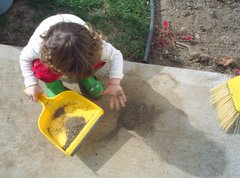 Over 50 years ago, a radio program sponsored a national contest to find the person with the funniest name. The lady who won had the name of Ima Haug. Her original name was something like Ima Huntington, but she married a man with the last name of Haug.
Over 50 years ago, a radio program sponsored a national contest to find the person with the funniest name. The lady who won had the name of Ima Haug. Her original name was something like Ima Huntington, but she married a man with the last name of Haug.I've thought the name as very fitting for most of us human beings, as the nature of a swine can be compared to both the best and the worst characteristics of the human race. Regardless of the stories of beautiful pigs given large clean spaces in which to roam and root, pigs do not groom themselves (like a cat), eat with no regard for what or how much, always have dirty noses, and defecate in their living area. I too can resemble a pig in being spiritually dirty, especially before I go to confession to ask the priest to forgive my sins.
When I was very small, I hated to have to take a bath because it shortened my outdoor play time. My Mother finally solved the problem when she bought a book with 365 small childrens' stories to be read nightly. The one-page story on my birth date had a drawing that impressed me. The picture was of another little girl who also hated baths. In the story, the little girl refused to take a bath and was punished by having to sleep with the pigs. I was asked by my Mother after the story if I would agree to take a bath, and of course, my answer was now 'yes'.
When I was growing up, we raised a few pigs, so I was aware how dirty they were. Their pen was always foul-smelling from spilled slop and hog manure. Moreover, it was not easy to recover the manure to fertilize farm fields and gardens, as we did with cow manure and chicken manure. So the pig manure had little value, except to eventually fertilize the area for planting a new garden, after moving the hog pen to another spot.
Pigs do have have numerous advantages over beef cattle.
- Pigs are omnivores so they will eat anything from soapy dishwater to dirt (which they consume when they find roots).
- Lots of baby pigs are born in a litter. I once observed 12 or 13 small piglets born to a large sow on an in-law's farm. Even the sow's owner was amazed that the baby pigs kept coming out!
- Pigs grow fast and produce pork chops, ham, and bacon--and these taste very good, especially when I smoke them.
- Pigs may produce replacement parts for human beings in the future because of their genetic similarity to human beings (and several other factors).
In Hawaii, the native Islanders are allowed to kill wild hogs whenever they want. The native told me that wild pigs cause a significant amount of soil erosion on the Big Island. In Texas, dogs are used to hunt wild swine, although the man I spoke with said good dogs are often killed by wild hogs. The man recommended an alternative method to keep wild hogs from disturbing manicured grassy areas.
He suggested digging a ditch in a nearby area, dropping in a bushel of corn, and covering with packed soil. The wild hogs will smell the corn and come at night to root it out, leaving the unfenced grassy area alone. It would take a while before all the kernals would be found by the wild pigs. The man actually believed it was possible to train the wild pigs to eat only in areas where corn was used as reward. He thought this method would meet the demands of animal lovers who would raise a howl if wild hogs were simply shot.









1 comment:
Arizona has plenty of wild pigs called peccaries or 'javelinas'.
They are North America's only native pig.
They live mostly out in the desert; and especially up in the mountains. They are far from friendly, and are VERY capable of defending themselves with their razor-sharp tusks. Much like native Arizonans themselves, I suppose -- except for the tusks. :)
Still, I'll bet javelinas make a tasty stew. If I ever catch one, I'll be sure to let this blog know how they taste, and all the details about how to catch a javelina.
Erick
Post a Comment